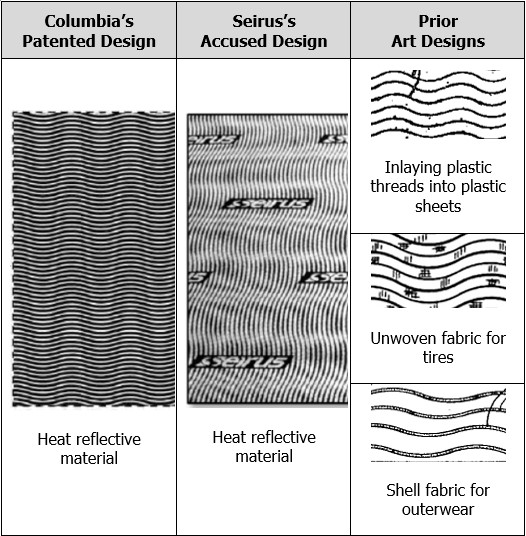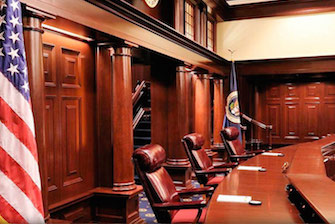Federal Circuit Lowers Bar for Proving Design Patent Infringement | Morgan Lewis
In a much-anticipated opinion that addresses an issue of first impression, the US Court of Appeals for the Federal Circuit narrowed the scope of “comparison prior art”―prior art considered by the fact finder during an infringement analysis―to the same article of manufacture claimed by the patented design. The decision harmonizes the scope of comparison prior art with that of invalidating prior art and will motivate design patent owners to revisit their enforcement and procurement strategies.
The Federal Circuit recently handed down its second precedential opinion in Columbia Sportswear North America, Inc. v. Seirus Innovative Accessories, Inc.[1] (Columbia II), a decade-long dispute in which Columbia accused Seirus of infringing Columbia’s US Design Patent No. D657,093 (the D’093 patent) by selling gloves and other apparel incorporating Seirus’s HeatWave material.
BACKGROUND
Although the dispute has garnered significant commentary on the role of logos in assessing design patent infringement, the Federal Circuit opinion highlights the role of prior art in determining whether a design patent is infringed by an accused design.
Design patent infringement turns on whether the ordinary observer would find the accused design to be “substantially similar” to the claimed design, such that they would be deceived into purchasing the accused design believing it to be the claimed design. [2] Unless the claimed and accused designs are plainly dissimilar, the “ordinary observer” test applies in view of prior art designs to provide a frame of reference for determining whether one design resembles another.[3] When viewed by the fact finder, “[c]omparison prior art can help highlight distinctions [and similarities] between the claimed and accused designs.”[4]
After the district court originally granted summary judgment of infringement in Columbia’s favor, the Federal Circuit’s initial opinion (Columbia I), vacated and remanded after finding that the district court erred by failing to consider the logo applied to Seirus’s alleged infringing thermal fabric during its infringement analysis.[5] On remand, a jury eventually returned a verdict of no infringement in view of three comparison prior art references that Seirus submitted for the infringement analysis: US Patent Nos. 2,539,690 (directed to inlaying plastic threads into plastic sheets); 1,515,792 (directed to unwoven fabric for tires); 5,626,949 (directed to shell fabric for outerwear) (see below table).
Even though the D’093 patent claimed the ornamental design for “heat reflective material,” the district court allowed consideration of these prior art designs for disclosing “wave patterns on fabric.” The court instructed jurors that they must decide for themselves what constitutes comparison prior art. Columbia once again appealed, but this time challenged, among other things, the district court’s jury instruction on the permissible scope of comparison prior art.
FEDERAL CIRCUIT DECISION
On appeal, the Federal Circuit ultimately sided with Columbia, holding for the first time that, “to qualify as comparison prior art, the prior-art design must be applied to the article of manufacture identified in the claim.”
While the issue was one of first impression, the court recognized that its holding also aligns with other design patent infringement precedent that narrowed the scope of prior art to the particular article of manufacture claimed by the patented. In Surgisil, for example, the court held that a prior art design is not anticipatory unless applied to the same article of manufacture,[6] while the Curver court extended that reasoning to the infringement analysis, holding that an accused design cannot infringe unless applied to the same article of manufacture claimed by the patent.[7]
This narrowing, the Columbia II court reasoned, aligns with the purpose behind comparison prior art: “to help inform an ordinary observer’s comparison between the claimed and accused designs—designs that, necessarily, must be applied to the same article of manufacture.”[8] The court also found that “using the same scope for anticipatory prior art and comparison prior art makes good practical sense” because the existing standard is easy to articulate and provides clear boundaries.[9] Since the district court unavoidably did not instruct the jury on the Federal Circuit’s new standard for determining comparison prior art, its failure to do so was reversible error and prejudicial. The Federal Circuit therefore vacated the noninfringement judgment and remanded for further proceedings.
Lastly, the Federal Circuit also confirmed its prior holding from Columbia I―that logos incorporated into the accused design must be considered by the fact finder during the infringement analysis―without much more: “[J]ust because a logo’s potential to eliminate confusion as to source is irrelevant to design-patent infringement, its potential to render an accused design dissimilar to the patented one – maybe even enough to establish non-infringement as a matter of law– should not be discounted.”[10]
Appreciating “the potential for a jury to be led astray and mistakenly conflate the significance of a logo’s source-identifying function with whatever impact it might have on a comparison of the designs,” the Columbia II court did find that the trial court had properly instructed the jury on the relevancy of logos for infringement analysis.
Rather than mandate a logo instruction for the jury in every design case, the Federal Circuit will entrust the trial court with the discretion to decide whether and when to clarify the relevancy of logos during the course of a jury trial.
PRACTICAL CONSIDERATIONS
Using the same standard for appropriate prior art in the patentability, infringement, and comparison art analyses will very likely reduce uncertainty going forward. By aligning these three standards, litigants, courts, applicants, and the US Patent and Trademark Office (USPTO) can benefit from guidance across the spectrum of prior art analyses.
From a patent owner’s perspective, this decision should reduce uncertainty during litigation by limiting prior art that can be introduced at all stages of a litigation.
Applicants will want to walk the balance of claiming narrowly enough to avoid prior art, but not so narrow as to unduly limit the claim for enforcement purposes. Because invalidating and narrowing art can potentially be avoided by choosing a specific title/article of manufacture, applicants will likely be better served using a title/claim that more closely matches the commercial product rather than an overly generic title/claim. Applicants may also benefit from including support in their filings for various titles and filing one or more continuations or concurrent filings directed to different articles of manufacture to make it more difficult to avoid infringement.
If applicants do decide to pursue narrower claims as a result of this decision, doing so may eventually help applicants and the USPTO conduct better searches and allow the patent office to more accurate classify applications, further improving searches for patentability, invalidity, and freedom-to-operate analyses.
OPEN QUESTIONS
Columbia II will likewise increase focus on claim construction for design patent claims, but it remains to be seen how lower courts will apply its holding.
On appeal, Columbia had argued that the prior art references were improperly admitted as comparison prior art since they did not involve designs applied to heat reflective materials. But the Federal Circuit declined to directly rule on the references’ admissibility, instead vacating and remanding for the district court to reconsider the issue under the new, narrower requiring comparison prior art to be applied to the claimed article of manufacture. The court suggested that the district court conduct a claim construction on the term “heat reflective material” before determining whether the references fit within the scope.
[1] No. 2021-2299, __ F.4th __ (Fed. Cir. Sept. 15, 2023).
[2] Gorham Co. v. White, 81 U.S. 511 (1871).
[3] Egyptian Goddess, Inc. v. Swisa, Inc., 543 F.3d 665, 678 (Fed. Cir. 2008).
[4] Id. at 676.
[5] Columbia Sportswear N. Am., Inc. v. Seirus Innovative Accessories, Inc., 942 F.3d 1119 (Fed. Cir. 2019) (Columbia I).
[6] In re SurgiSil LLP, No. 2020–1940 (Fed. Cir. Oct. 4, 2021).
[7] Curver Luxembourg, SARL v. Home Expressions Inc., 938 F.3d 1334, 1340 (Fed. Cir. 2019).
[8] Columbia II, 2022 WL 5988026 at *9.
[9] Id. at *10.
[10] Id. at *30.
[View source.]






